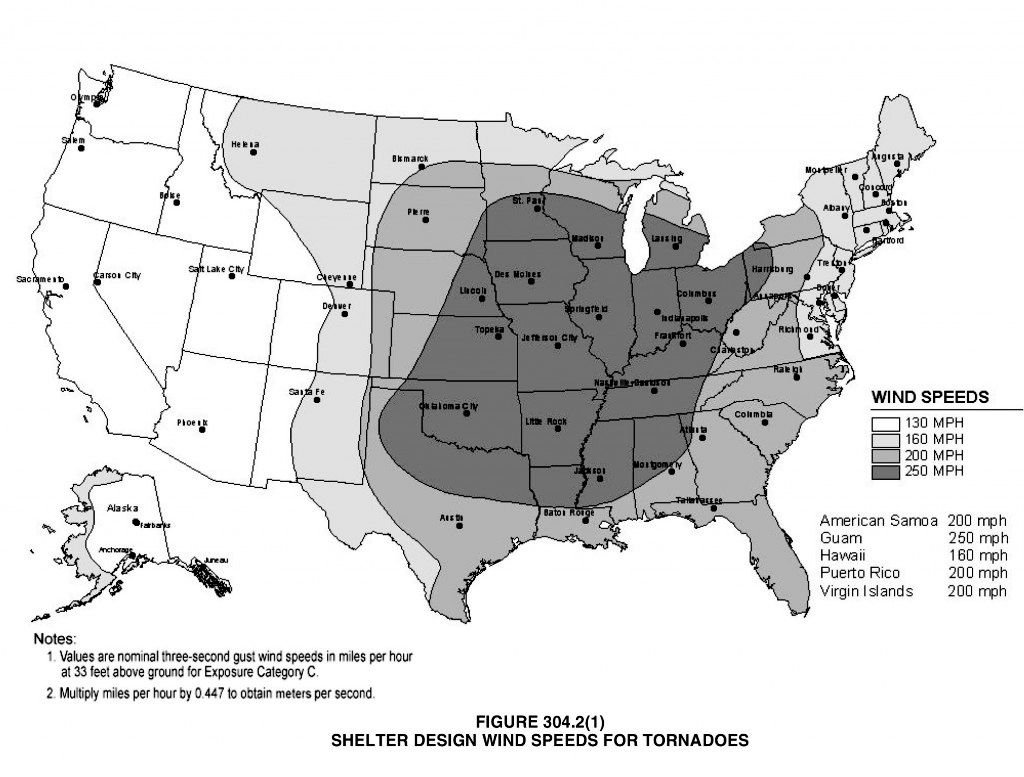Safe Room Storm Shelter | Demystifying Storm Shelters
Safe room storm shelters are constructed to keep occupants safe during a severe weather event.
Does a Tornado and Hurricane Safe Room Storm Shelter have the same requirements?
Why have a school safe room shelter?
More schools, universities and public buildings are incorporating safe rooms in schools as well as community safe rooms into their buildings, not just the ones located in required areas. More areas, especially outside areas not defined as in the 250 MPH zone (see map below) are finding that including storm safe rooms during construction or while renovating, can have many benefits when severe weather situations occur.
Fundamentally, a safe room storm shelter is constructed to keep occupants safe during a severe weather event. While there are entire books written about the specific safe room requirements, a few key requirements, according to ICC-500, that you should be aware of are as follows:
- Protects from Wind and Flying Debris
- Hardened Infrastructure Required
- Occupancy Load and Duration
- Occupant Safety
There are multiple methods, ways and designs that can help meet all of the requirements.
Occupant Safety is one requirement that can be confusing. During an event that would require a safe room storm shelter (i.e., a tornado or hurricane) there are minimum levels of occupant safety essential features required. Safe room occupancy is defined differently for a tornado event as compared to a hurricane event. Things like quantity or duration of first aid kits, ventilation/HVAC, sanitation management, lighting, standby power, water supply, and more defined by FEMA. Typically, safe rooms designed for tornadoes require less provisioning than ones designed for hurricanes, but it’s important to note that FEMA P-361 states that “higher standards related to safe room occupant comfort may even be required by the Authority Having Jurisdiction is also known as AHJ (e.g. school district).
Want to find out more even information about storm shelters?
Download our free e-book today!
Download our free storm shelter ebook now!
![]()
HURRICANE VS. TORNADOES
Pressure equalizes more during a hurricane while tornadoes come on more instantly. Storm shelters for hurricanes require you to build for duration more than intensity. Generally, tornadoes are quicker with high winds, spewing projectiles at high speeds.
![]()
TORNADO ALLEY
It is required for an area with an increased risk of tornadoes or any state or locality that has adopted IBC 2015 or newer to have a storm shelter meeting the FEMA-361 requirements for all K-12 schools with 50 or more occupants, 911 call stations, police stations, fire, rescue and ambulance stations and more.
![]()
STORM SHELTERS
An inside area within a building, or a separate building altogether, which is created to protect occupants from tornadoes or hurricanes. Some of the most common areas to be converted are gymnasiums, classrooms and cafeterias.
How much wind does your area need to withstand?

Wind zones are areas of the United States that get (on average) different maximum speed winds. The higher the winds, the higher the chance of a tornado or hurricane and the more damage it can do. This does not mean, however, that the surrounding areas are not of concern. Even in the 160 mph zone, tornadoes can develop and cause devastating damage to the area. 160 mph can still tear off roofs and turn over cars. These areas are generally less prepared for a storm of this magnitude, since they are less likely. When you are underprepared it can, in turn, have a greater impact on the people and the possessions in that area.





